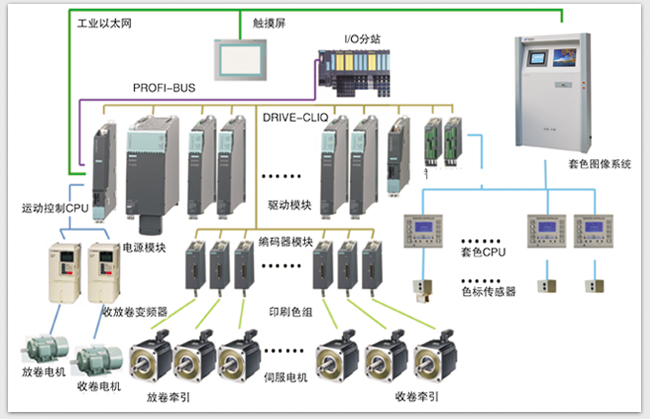
Servo controller solution
Solutions of electrical part of printing and packaging equipment based on servo controller

Advantages of electronic shaft compared with traditional mechanical shaft
The transmission of traditional printing equipment relies on the mechanical parts such as gear, shaft rod fixed on the machine to drive the power of the motor to each unit. The so-called shaftless technology is to replace the traditional and complex mechanical transmission shaft with the (virtual) electronic axis driven by Siemens AC servo motor. Some people also call shaftless technology gearless transmission technology.
The drive and control of this system use the precise Siemens electronic synchronous digital intelligent servo motor and rely on the precise synchronous control of the intelligent servo motor drive, instead of the mechanical gearbox, longitudinal shaft, cardan shaft and cam which are widely used but expensive so far. So there is no need for additional power, such as special gearbox.
The shaftless drive press is an open structure. For shaftless drive press, the independent drive unit of modular design has made the equipment not need to transfer the power to each unit through the main shaft, not need to transfer the torque through the high-precision gearbox, nor need the lubrication system of the gearbox.
The shaftless drive printing machine will not have some problems due to inaccurate mechanical manufacturing and installation, so it will not have factors that affect the overprint accuracy due to gear transmission, reduce the noise when the equipment is running, improve the energy consumption efficiency, and make better use of space.
Siemens shaftless transmission technology adopts the latest drive Cliq real-time serial communication transmission interface system based on Industrial Ethernet of Siemens motion control, which greatly simplifies personnel training, production management and equipment maintenance by coordinating each transmission device with ultra-high speed clock synchronization.
The drive unit improves the synchronous coordination of the tension regulating roller, which provides great convenience for regulating speed.
Each driving unit has an independent prosai registration system, and the registration control response is extremely fast. The control signal directly acts on the Siemens AC servo motor, and the motor directly acts on the adjustment of the phase of the plate roller, which provides a reliable guarantee for the fast response.
• for equipment manufacturers, Siemens prosai shaftless system reduces the cost to the maximum extent. The concept of shaftless drive equipment first means the reduction of development, production and operation costs.
For the end-user, compared with the traditional printing machine driven by motor, spindle, gear and clutch, the shaftless printing machine greatly reduces the waste products caused by the mechanical structure of the printing machine, thus minimizing the printing cost.
As each printing unit has the pre registration function, it can be completed and registered quickly, thus reducing the waste products generated in the initial adjustment of the set on time.
• during the roll change, the printing waste caused by the tension change during the roll change is greatly reduced due to the independent drive of each printing unit.
As the AC servo motor of Siemens drive system has extremely sensitive dynamic response characteristics and digital adjustment mechanism, as long as the parameters are changed, it can adapt to the production requirements of different movable parts; while the traditional printing machine needs to change the mechanical structure to adapt to the production requirements of different movable parts.
In this way, the machining cost of the machine is reduced, and the unproductive preparation time required for changing these structures is also reduced. The application of the electronic axis enables users to input only one parameter value, and the digital control system can guarantee the accurate repeated reprinting, thus reducing the scrap rate and cost.
Each turn of AC servo motor has more than 4 million pulses, which can be used for very precise positioning and better control of position and speed. With Siemens intelligent driver and prosai high-speed automatic registration system, the control of registration accuracy can be greatly improved.
When using the traditional gear and shaft drive system, the inevitable torque instability and gear hysteresis will lead to the drift of registration, especially when accelerating or decelerating. If the more and longer the transmission shaft, the more and larger the gears, the greater the accumulated error coefficient, which can be avoided in the Siemens shaftless transmission and control system. In addition, the mechanical wear of gear is inevitable in the use process, and the error will increase, and the gear is the main factor of stripe (or bar) fault in printing.
It is no longer limited by the gear pitch without the traditional gear driving the rotation of the roller on the printing machine, and the repeated length of the printed matter has no fixed limitation, but can be adjusted at will, which is particularly popular on the flexographic printing machine which adapts to the diversified specifications of the packaging printed matter. As long as the circumference of the plate roller is changed to the requirements, and the repeated length data is input into the control center.
• In addition to eliminating the high-power drive motor and reducing the power consumption, a series of mechanical transmission mechanisms, including the drive gear, gearbox, belt plate, belt and transmission shaft of the plate roller and the imprinting roller, are also cancelled. After the structure is simplified, the spare parts reserve is sharply reduced, and the maintenance downtime is reduced. Moreover, the AC synchronous servo motor is of the brush free structure, and its maintenance It's simpler and easier than a brush motor.
• the AC synchronous servo motor provides a highly constant torque throughout the operation process, with low inertia or hysteresis when changing speed quickly. Therefore, the resulting waste and defective products will be greatly reduced and the production efficiency will be improved. Especially in the case of more live short version



